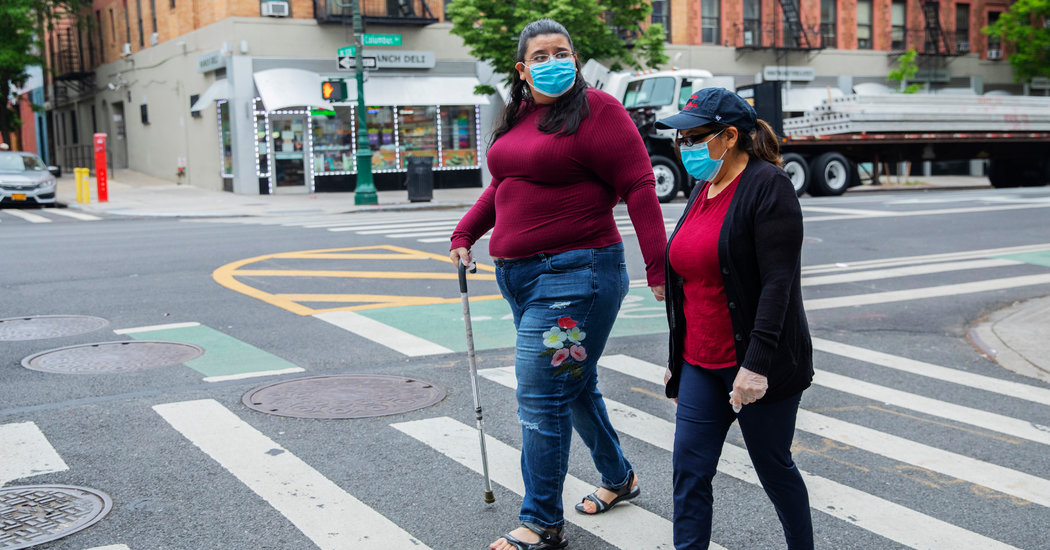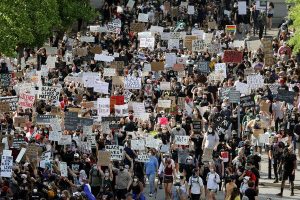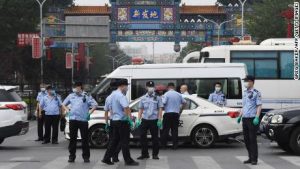Janet Mendez started receiving bills soon after returning in April to her mother’s home from Mount Sinai Morningside hospital, where she nearly died of Covid-19. First, there was one for $31,165. Unable to work and finding it difficult to walk, Ms. Mendez decided to put the bill out of her mind and focus on her recovery.
The next one was impossible to ignore: an invoice for $401,885.57, although it noted that the hospital would reduce the bill by $326,851.63 as a “financial assistance benefit.” But that still left a tab of more than $75,000.
“Oh my God, how am I going to pay all this money?” Ms. Mendez, 33, recalled thinking. The answer came to her in about a second: “I’m not going to be able to pay all this.”
Ms. Mendez is optimistic that her insurance company will cover a large part of the costs, but only after receiving a series of harassing phone calls from the hospital about payment.
A spokesman for the hospital told The Times that Ms. Mendez erroneously received a bill that should have gone directly to her insurance company or the government. Coronavirus patients, through a series of federal aid packages, are supposed to be largely exempt from paying for the bulk of their care.
But mistakes are likely to occur, particularly given the number of people who have recently lost their health insurance amid an economic downturn and widespread job loss. And when they do happen, patients like Ms. Mendez will be the ones to have to sort out the complicated billing process at a time when they are still recovering from Covid-19.
“We’re looking at a tsunami,” said Elisabeth Benjamin, a vice president at the Community Service Society of New York, which is trying to help Ms. Mendez get her bill reduced. “The earthquake has struck, and now we’re waiting for the bills to roll on in.”
When Ms. Mendez got over the initial shock and examined her bill more closely, she was struck by how vague and arbitrary the charges seemed. She was billed $3,550 for “inpatient charges” and another $42,714.52 for “pharmacy,” but without any breakdown of what medicines she received or how much each cost.
Ms. Mendez said the bill should have at least been itemized, listing each drug she was being charged for — and the price. She was, after all, unconscious for much of her hospitalization.
“I don’t know what medicines they put in me,” she said. “I can’t say they did this, or they didn’t do this.”
Most of the line items on her hospital bill are vague. Some of the most expensive are four entries that simply read “Medical — Cardiac Care.” Each one ranges from $41,000 to $82,000.
Part of the confusion was that Ms. Mendez had recently changed health insurers, and she had arrived at the hospital struggling to breathe and without her new insurance information. The hospital billing department concluded she was uninsured and sent her a bill directly.
“To be clear, neither this patient nor any Mount Sinai patient should receive a bill or be expected to directly pay for their Covid-19 care,” a spokesman for Mount Sinai Health System, Jason Kaplan, wrote in an email, describing it as an isolated error.
While eye-popping medical bills are nothing new, Covid-19 patients are supposed to be largely exempt. During Ms. Mendez’s hospitalization, a huge bailout of hospitals was taking shape.
In New York City, hospitals received more than $3 billion in federal payments last month from an early round of bailout payments. The hospital where Ms. Mendez was treated, Mount Sinai Morningside (formerly Mount Sinai St. Luke’s) received at least $63.7 million.
The federal dollars are intended to help compensate hospitals and health care providers for the expense of treating Covid-19 patients like Ms. Mendez. The money is also meant to help make up for the revenue hospitals lost as elective procedures were canceled and non-Covid patients dwindled.
The money comes with some conditions that are intended to protect patients from medical debt. For instance, health care providers are not permitted to seek extra payment from patients with health insurance who received care at an out-of-network hospital. Nor can they “balance-bill” — that is, bill the patient for the difference between what the insurer will pay and the hospital’s charges.
But the protections do not fully insulate patients. Even if a hospital takes federal money, some of the doctors who treat patients there can send their own bills to patients directly.
Ms. Mendez received a bill separate from the hospital. The doctors who cared for her individually charged between $300 and $1,800 for each day. Some days, four different doctors billed her for treatment.
Depending on their insurance plan, patients may still be stuck with paying co-payments, deductibles and a percentage of the bill — which can amount to thousands of dollars, although some plans may limit out-of-pocket costs, said Jack Hoadley, a health policy researcher at Georgetown University.
-
Frequently Asked Questions and Advice
Updated June 12, 2020
-
What’s the risk of catching coronavirus from a surface?
Touching contaminated objects and then infecting ourselves with the germs is not typically how the virus spreads. But it can happen. A number of studies of flu, rhinovirus, coronavirus and other microbes have shown that respiratory illnesses, including the new coronavirus, can spread by touching contaminated surfaces, particularly in places like day care centers, offices and hospitals. But a long chain of events has to happen for the disease to spread that way. The best way to protect yourself from coronavirus — whether it’s surface transmission or close human contact — is still social distancing, washing your hands, not touching your face and wearing masks.
-
Does asymptomatic transmission of Covid-19 happen?
So far, the evidence seems to show it does. A widely cited paper published in April suggests that people are most infectious about two days before the onset of coronavirus symptoms and estimated that 44 percent of new infections were a result of transmission from people who were not yet showing symptoms. Recently, a top expert at the World Health Organization stated that transmission of the coronavirus by people who did not have symptoms was “very rare,” but she later walked back that statement.
-
How does blood type influence coronavirus?
A study by European scientists is the first to document a strong statistical link between genetic variations and Covid-19, the illness caused by the coronavirus. Having Type A blood was linked to a 50 percent increase in the likelihood that a patient would need to get oxygen or to go on a ventilator, according to the new study.
-
How many people have lost their jobs due to coronavirus in the U.S.?
The unemployment rate fell to 13.3 percent in May, the Labor Department said on June 5, an unexpected improvement in the nation’s job market as hiring rebounded faster than economists expected. Economists had forecast the unemployment rate to increase to as much as 20 percent, after it hit 14.7 percent in April, which was the highest since the government began keeping official statistics after World War II. But the unemployment rate dipped instead, with employers adding 2.5 million jobs, after more than 20 million jobs were lost in April.
-
Will protests set off a second viral wave of coronavirus?
Mass protests against police brutality that have brought thousands of people onto the streets in cities across America are raising the specter of new coronavirus outbreaks, prompting political leaders, physicians and public health experts to warn that the crowds could cause a surge in cases. While many political leaders affirmed the right of protesters to express themselves, they urged the demonstrators to wear face masks and maintain social distancing, both to protect themselves and to prevent further community spread of the virus. Some infectious disease experts were reassured by the fact that the protests were held outdoors, saying the open air settings could mitigate the risk of transmission.
-
How do we start exercising again without hurting ourselves after months of lockdown?
Exercise researchers and physicians have some blunt advice for those of us aiming to return to regular exercise now: Start slowly and then rev up your workouts, also slowly. American adults tended to be about 12 percent less active after the stay-at-home mandates began in March than they were in January. But there are steps you can take to ease your way back into regular exercise safely. First, “start at no more than 50 percent of the exercise you were doing before Covid,” says Dr. Monica Rho, the chief of musculoskeletal medicine at the Shirley Ryan AbilityLab in Chicago. Thread in some preparatory squats, too, she advises. “When you haven’t been exercising, you lose muscle mass.” Expect some muscle twinges after these preliminary, post-lockdown sessions, especially a day or two later. But sudden or increasing pain during exercise is a clarion call to stop and return home.
-
My state is reopening. Is it safe to go out?
States are reopening bit by bit. This means that more public spaces are available for use and more and more businesses are being allowed to open again. The federal government is largely leaving the decision up to states, and some state leaders are leaving the decision up to local authorities. Even if you aren’t being told to stay at home, it’s still a good idea to limit trips outside and your interaction with other people.
-
What are the symptoms of coronavirus?
Common symptoms include fever, a dry cough, fatigue and difficulty breathing or shortness of breath. Some of these symptoms overlap with those of the flu, making detection difficult, but runny noses and stuffy sinuses are less common. The C.D.C. has also added chills, muscle pain, sore throat, headache and a new loss of the sense of taste or smell as symptoms to look out for. Most people fall ill five to seven days after exposure, but symptoms may appear in as few as two days or as many as 14 days.
-
How can I protect myself while flying?
If air travel is unavoidable, there are some steps you can take to protect yourself. Most important: Wash your hands often, and stop touching your face. If possible, choose a window seat. A study from Emory University found that during flu season, the safest place to sit on a plane is by a window, as people sitting in window seats had less contact with potentially sick people. Disinfect hard surfaces. When you get to your seat and your hands are clean, use disinfecting wipes to clean the hard surfaces at your seat like the head and arm rest, the seatbelt buckle, the remote, screen, seat back pocket and the tray table. If the seat is hard and nonporous or leather or pleather, you can wipe that down, too. (Using wipes on upholstered seats could lead to a wet seat and spreading of germs rather than killing them.)
-
How do I take my temperature?
Taking one’s temperature to look for signs of fever is not as easy as it sounds, as “normal” temperature numbers can vary, but generally, keep an eye out for a temperature of 100.5 degrees Fahrenheit or higher. If you don’t have a thermometer (they can be pricey these days), there are other ways to figure out if you have a fever, or are at risk of Covid-19 complications.
-
Should I wear a mask?
The C.D.C. has recommended that all Americans wear cloth masks if they go out in public. This is a shift in federal guidance reflecting new concerns that the coronavirus is being spread by infected people who have no symptoms. Until now, the C.D.C., like the W.H.O., has advised that ordinary people don’t need to wear masks unless they are sick and coughing. Part of the reason was to preserve medical-grade masks for health care workers who desperately need them at a time when they are in continuously short supply. Masks don’t replace hand washing and social distancing.
-
What should I do if I feel sick?
If you’ve been exposed to the coronavirus or think you have, and have a fever or symptoms like a cough or difficulty breathing, call a doctor. They should give you advice on whether you should be tested, how to get tested, and how to seek medical treatment without potentially infecting or exposing others.
-
How do I get tested?
If you’re sick and you think you’ve been exposed to the new coronavirus, the C.D.C. recommends that you call your healthcare provider and explain your symptoms and fears. They will decide if you need to be tested. Keep in mind that there’s a chance — because of a lack of testing kits or because you’re asymptomatic, for instance — you won’t be able to get tested.
-
And significantly, some of the conditions imposed with the bailout funds only apply to patients with insurance.
Hospitals can seek reimbursement from the government for treating uninsured patients through a different process. But it may turn out that uninsured patients still receive bills.
Ms. Mendez has submitted the bill to Cigna, her new insurer, and said that she was led to believe her share of it will be under $10,000.
Like thousands of other gravely ill Covid-19 patients in New York City, Ms. Mendez, an office administrator for a Domino’s Pizza franchise, had been deeply sedated and placed on a ventilator to keep her breathing soon after arriving at the hospital on March 25. She was in the hospital for 19 nights.
When she awoke, she could not remember her own name or where she was, she said in an interview.
It was a day or two before her memory returned and her confusion receded.
When she was discharged, an ambulance took her to her mother’s home.
At first her mother tried to keep the bills from her. But then Ms. Mendez said began to get phone calls from Mount Sinai asking her how she intended to pay.
She is hopeful that insurance will cover the vast majority of the charges. But she is also worried that more bills will arrive.
“I haven’t seen anything that says ‘ambulance’ on it,” she said, wondering if she was going to be charged for the ride to the hospital. Then she remembered that she left the hospital by ambulance as well. “Maybe I’ll be charged for both of them.”



















